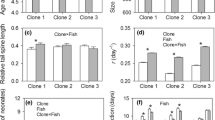Abstract
In the spring of 2009, tilapia Orechromis sp. were discovered in waterways near Port Sulphur, Louisiana. The potential naturalization of this population is of great concern as this invasive species can drastically disrupt fish community structure. Identification as an Oreochromis hybrid occurred through allozyme analysis, and our project investigated tilapia thermal tolerances at environmentally relevant salinities to determine lethal limits. In the laboratory, tilapia were acclimated for 1 month at salinities of 0.8, 7.0, or 15.0 ppt (g/L). Initial water temperatures of 26 C were decreased 2 C per day for all three acclimation salinities and 1 C per day for a cohort acclimated at 7 ppt until 100 % mortality of tilapia was observed. Tilapia acclimated to salinities of 0.8 and 7 ppt lost equilibrium at 10 C, while 15.0 ppt-acclimated individuals lost equilibrium at 8 C. Mortality within all acclimation salinities occurred between 8 and 6 C, with median lower lethal temperatures for all acclimations calculated between 6.0 and 6.6 C. Salinity acclimation prior to the thermal tolerance challenge did not alter cold tolerance. Experimental data were statistically modeled with field temperature data, and our results suggest low potential for tilapia naturalization, except in developed areas.


Similar content being viewed by others
References
Behrends LL, Kingsley JB, Bulls M (1990) Cold tolerance in maternal mouthbrooding tilapias: phenotypic variation among species and hybrids. Aquaculture 85:271–280
Beitinger TL, Bennett WA, McCauley RW (2000) Temperature tolerances of North American freshwater fishes exposed to dynamic changes in temperature. Environ Biol Fishes 58:237–275
Bennett WA, Currie R, Wagner PF, Beitinger TL (1997) Cold tolerance and potential overwintering of redbodied piranha, Pygocentrus nattereri, in the United States. Trans Am Fish Soc 126:841–849
Bentsen HB, Eknath AE, Palada-de Vera MS, Danting JC, Bolivar HL, Reyes RA, Dioniso EE, Longalong FM, Circa AV, Tayamen MM, Gjerde B (1998) Genetic improvement of farmed tilapias: growth performance in a complete diallel cross experiment with eight strains of Oreochromis niloticus. Aquaculture 160:145–173
Costa-Pierce BA, Riedel R (2000) Fisheries ecology of the tilapias in subtropical lakes of the United States. In: Costa-Pierce BA, Rakocy JE (eds) Tilapia aquaculture of the Americas, vol 2. World Aquaculture Society, Baton Rouge, pp 1–20
Courtenay WR Jr (1991) Biological pollution through fish introductions. In: McKnight BN (ed) BN biological pollution: the control and impact of invasive exotic species. Indiana Academy of Science, Indianapolis, pp 35–61
Cnaani A, Hulata G, Gall1 GAE, Kashi Y, Indelman M, Hallerman EM (2000) Detection of putative QTLs for body weight and cold tolerance in interspecific tilapia hybrids. In: Genetics in Aquaculture VII, Townsville, Australia, 15–22 July 2000
Crutchfield JU Jr (1995) Establishment and expansion of redbelly tilapia and blue tilapia in a power plant cooling reservoir. In: Schramm HL, Piper RG (eds) Uses and effects of cultured fishes in aquatic ecosystems. American Fisheries Society, Bethesda, pp 452–461
FAO (Food and Agriculture Organization) (2004) State of World Fisheries and Aquaculture (SOFIA). FAO, Rome
Hargreaves JA (2000) Tilapia culture in the southeast United States. In: Costa-Pierce BA, Rakocy JE (eds) Tilapia aquaculture in the Americas, vol 2. World Aquaculture Society, Baton Rouge, pp 60–81
Korni MS, Vander Zanden MJ (2010) Forecasting the distribution of the invasive round goby (Neogobius melanostomus) in Wisconsin tributaries to Lake Michigan. Canadian Journal of Fisheries and Aquatic Sciences 67:553–562
Likongwe JS, Stecko TD, Stauffer JR, Carline RF (1996) Combined effect of water temperature and salinity on growth and feed utilization of juvenile Nile tilapia Oreochromis niloticus (Linneaus). Aquaculture 146:37–46
Marshall B (2009) Section of Plaquemines waterways to be poisoned to kill foreign fill. The New Orleans Times-Picayune. 6 May 2009. http://www.nola.com/news/index.ssf/2009/05/section_of_plaquemines_waterwa.html
McBay LG (1961) The biology of tilapia nilotica linneaus. Proceed Annu Conf Southeastern Assoc Game Fish Commission 15:208–218
Peterson MS, Slack WT, Woodley (2005) The occurrence of non-indigenous Nile tilapia, Oreochromis niloticus (Linnaeus) in coastal Mississippi, USA: ties to aquaculture and thermal effluent. Wetlands 25:112–121
Pörtner HO, Knust R (2007) Climate change affects marine fishes through the oxygen limitation of thermal tolerance. Science 5:95–97
Schoenherr A (1988) A review of the life history of the dessert pupfish, Cyprinodon macularius. Bull South Calif Acad Sci 87:104–134
Schofield PJ, Peterson MS, Lowe MR, Brown-Peterson NJ, Slack WT (2011) Survival, growth and reproduction of non-indigenous Nile tilapia, Oreochromis niloticu (Linneaus 1758). I. Physiological capabilities in various temperatures and salinities. Mar Freshw Res 62:439–449
Shafland PL, Pestrak JM (1982) Lower lethal temperatures for fourteen nonnative fishes in Florida. Environ Biol Fishes 7:149–156
Spiegelman D, Hertzmark E (2005) Easy SAS calculations for risk or prevalence ratios and differences. Am J Epidemiol 162:199–200
Tayamen MM, Reyes RA, Danting MJ, Emdoza AM, Marquez EB, Salguet AC, Gonzales RC, Abella TA, Vera-Cruz EM (2002) Tilapia broodstock development for saline waters in the Philippines. Naga, The ICLARM Quaterly 25:1
Tave D, Jayaprakas V, Smitherman RO (1990) Effects of intraspecific hybridization in Tilapia nilotica on survival under ambient winter temperature in Alabama. J World Aquaculture Soc 21:201–204
Trewavas E (1982) Tilapias: taxonomy and speciation. In: Pullin RSV, Lowe-McConnell RH (eds) The biology and culture of tilapias, ICLARM conference proceedings 7. International center for living aquatic resources management, Manila, pp 3–15
Watanabe WO, Burnett KM, Olla BL, Wicklund RI (1989) The effects of salinity on reproductive performance in Florida red tilapia. J World Aquaculture Soc 20:223–229
Zale AV, Gregory RC (1989) Effect of salinity on cold tolerance of juvenile blue tilpias. Trans Am Fish Soc 118:718–720
Author information
Authors and Affiliations
Corresponding author
Rights and permissions
About this article
Cite this article
Green, C.C., Kelso, W.E., Kaller, M.D. et al. Potential for Naturalization of Nonidigenous Tilapia Orechromis sp. in Coastal Louisiana Marshes Based on Integrating Thermal Tolerance and Field Data. Wetlands 32, 717–723 (2012). https://doi.org/10.1007/s13157-012-0304-x
Received:
Accepted:
Published:
Issue Date:
DOI: https://doi.org/10.1007/s13157-012-0304-x




